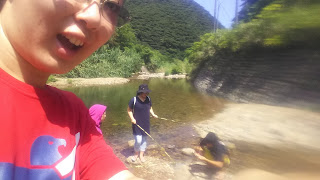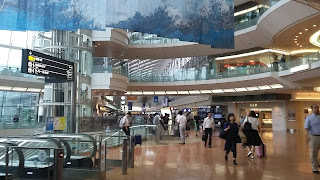 |
| Amami Orchestra performs Beethoven's Ninth under the baton of Maestro Sakamoto |
July
Before departing for Japan, I had emailed the Amami Orchestra to let them know I was interested in joining. From their website, I found out that a performance of Beethoven's Ninth (affectionately known as "daiku" in Japan, lit. "the ninth") was planned for December, so as a good music graduate I printed off the cello part and started learning it.
 |
| You can't practice cello on a plane, but you can music |
August
Sectional rehearsals for the fourth movement are held for cellos and basses. For those unfamiliar, the entire symphony is actually comprised of four distinct parts, called "movements." Only the fourth movement contains the famous Ode to Joy melody, but the other three are no less unique.
The first movement of the piece begins like the rumble of a world coming into being, the stirrings of the "primordial soup of creation" as one of my professors at school put it. The second is a whirlwind of rhythmic chaos that pushes ever on. The third is a calm respite of two intertwined song-like melodies.
But in the fourth Beethoven does something rather creative: not only does he feature a chorus and vocal soloists, but also makes a callback to each of the previous three movements in turn. The fourth opens with a powerful declamation from the cellos and basses, but then! The rumbling of the first movement. The primordial soup makes an appearance, only to be denied by another operatic declamation by the lower strings. Next! The rhythmic pulsing of the second movement. Again denied. Then, the wind instruments sing a short phrase from the third movement. Denied. Finally, the Ode to Joy theme is heard for the first time in the wind instruments, but what's this? The lower strings give a forceful, final "no!" before easing into the first full statement of the famous melody.
This crazy narrative is very difficult for the lower strings because we are very exposed, so it takes everyone working together in unison to deliver the punches that Beethoven writes.
 |
| You can't tell in this photo, but I'm repping my UCI music tshirt. Yes, all of the regular orchestra cellists are women! |
September
Orchestra rehearsals proceed under the baton of Ebara-sensei - horn player, conductor, and UC Berkeley PhD graduate who arrived on Amami earlier in April. There are no oboe players or bassoon players living on Amami, so we have to do without them for now.
I also conduct the orchestra for the first time!
 |
| Rehearsing with Ebara-sensei |
 |
| Good thing I brought my baton. |
October/November
Maestro Sakamoto Masahiko (Sakamoto being the family name) is our conductor for the performance. Unfortunately Ebara-sensei to had leave Amami so we had to continue without his guidance.
On the 13th Sakamoto-sensei visited Amami and we had our first rehearsal with the chorus! Before coming to Japan my only firsthand experience of Beethoven's ninth was the aforementioned opening of the fourth movement, which was part of the audition repertoire for UCI Symphony in college. So rehearsing with a full choir (of Japanese people singing in German, no less - talk about cultural exchange!) was nothing short of amazing.
The 23rd was a national holiday, so I didn't have to work and could go to a special weekday rehearsal. I spent two whole hours conducting a small group through the first 18 measures of the third movement (to put that in context, that's about 1 minute of music). We don't usually get a chance to do such detailed work but today was all about exploring how changes in bow speed and placement help create phrasing. I'm really proud of the progress everyone made!!
 |
| The players who usually come to Wednesday rehearsal had to put up with my amateur conducting for the whole day... |
Then, the 27th was our last rehearsal with Sakamoto-sensei before performance weekend. He was very happy with the opening of the third movement so I guess I must have done something right??
IT'S HERE. Concert weekend! I bussed up to Naze on Friday evening for rehearsal. Because Amami does not have players for all the necessary orchestral parts, we called in reinforcements from Kagoshima and Tokyo, among other places. One of the two oboe players is Chiho, who until April was living on Amami as a music teacher and is friends with all the ALTs. Ebara-sensei also returned to play horn! We finished at around 9:30pm and went to a restaurant to hear traditional island music (shima-uta) performed live and to share a meal.
 |
| Island food! Tonkotsu, sashimi, pickled papaya, shrimp, and a whole bunch of other delicious things that I can't identify, but ate anyway. |
 |
| Our shima-uta performers for the evening. |
Saturday was another full day of rehearsal. All of our reinforcement players, except for two soloists arrived. After months without having double reeds or a horn section, it was really nice to play alongside those sound colors again. (If you who are reading this are currently in a symphony orchestra, please don't take those playing opportunities for granted!) The two soloists who were here (soprano and tenor) were fantastic and professional.
Sunday was an early start since we had to have a final dress rehearsal with all four soloists before performing. The doors opened at 2 pm and the first half of the concert began at 3 with several Amami-born soloists, a flautist, pianist, and clarinetist, playing solo/chamber work from Mozart, Chopin, and Brahms. The Mozart and Brahms were accompanied by the wonderful Tanaka Yuta.
After that it was time for Beethoven!
 |
| Violas and cellos. Our support cellist is a third-year music major in Nagoya, who has family on Amami. Photo by Seido |
 |
| Chiho (center) playing second oboe. Photo by Seido |
There were hiccups in the performance, but nothing major, and I thoroughly enjoyed it. Afterwards, the audience was invited to sing part of the finale as an encore, and the children's song "furusato." It was a really amazing sea of sound to be a part of, nearly 100 instruments and 1000+ voices raised in a hymn of universal brotherhood.
 |
| Thanks to Seido, Ching, and Megan for coming to the concert! |
 |
| Amakan. Sakamoto-sensei, the four soloists, and several others gave speeches! |
 |
| L-R: Hayashi-san (chorus alto), me (cello), Sakamoto-sensei (conductor), Fukushima-san (chorus alto). |
Parties like this often conclude with a big shout of "BANZAI!" but not this one. It was only appropriate to end this celebration with three big shouts of friendship, of "FREUDE!" I don't know if I'll be around for the next time "Daiku" is performed here, so I'll be sure to treasure my memories of this performance.
_____________
Many of these photos were lifted straight from the Amami Orchestra blog! If you can read Japanese (or are willing to put up with google translate), you can read the Daiku-related entries here.
An article was also written for the Amami newspaper. Check it out here.
My friend Tsundie did camera work for the concert and also keeps a blog. His entry can be found here.





































